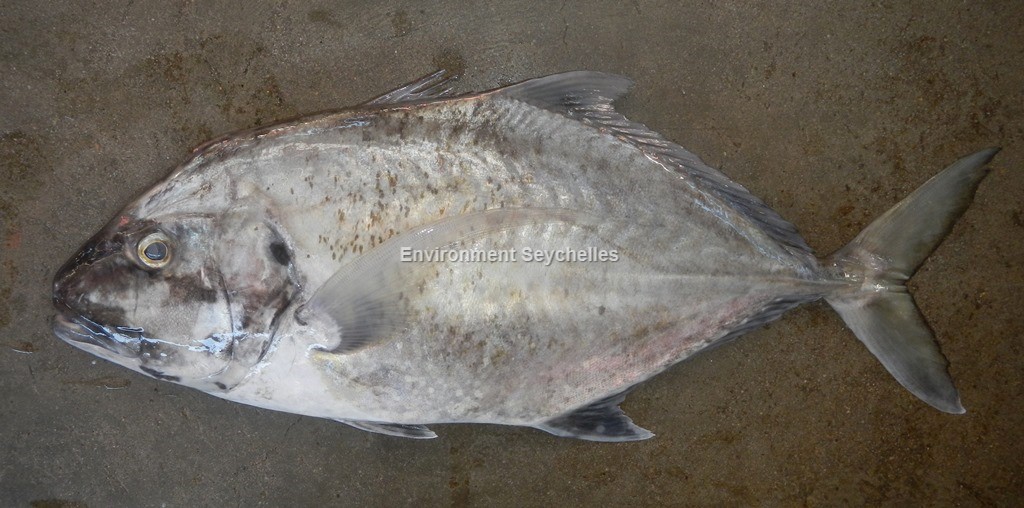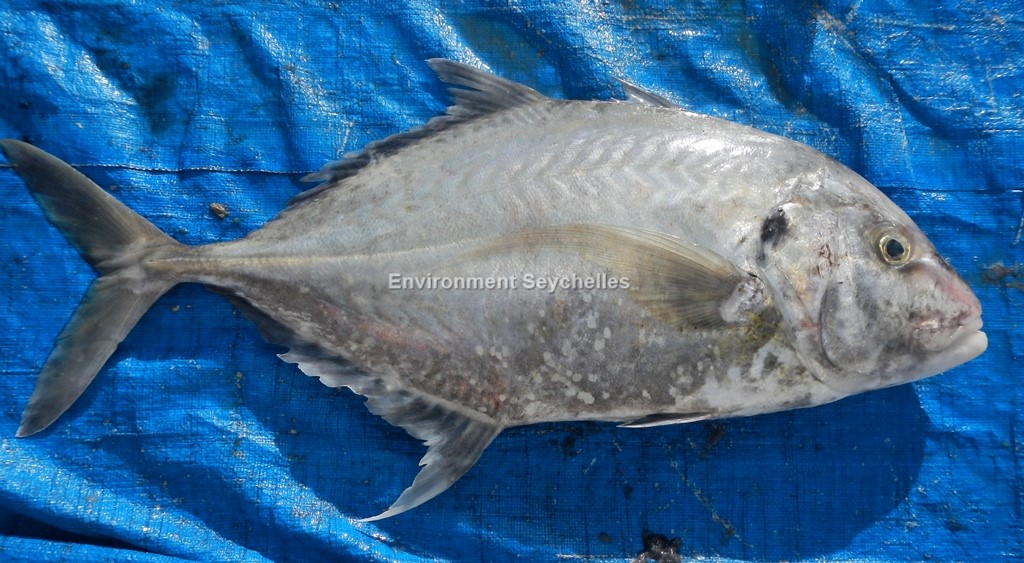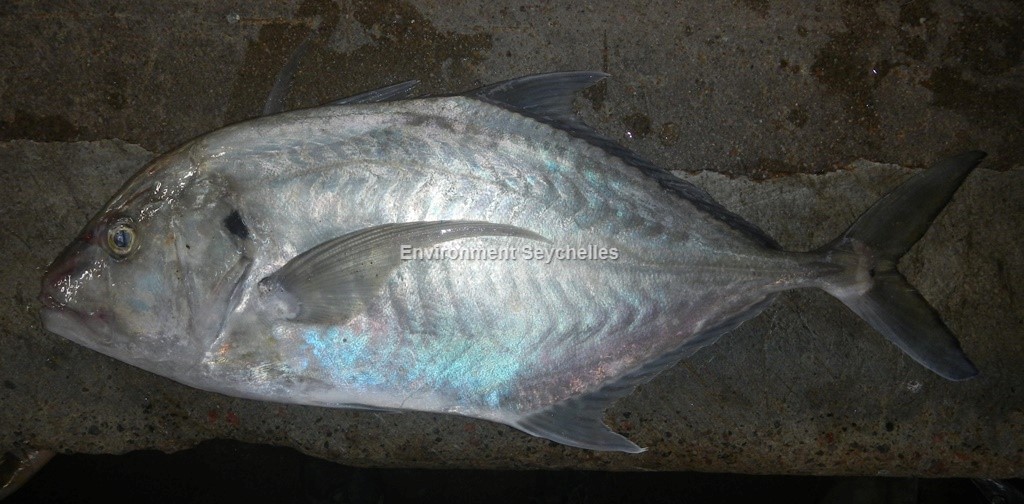Description:
Dorsal spines: 9; Dorsal rays: 18-20; Anal spines: 3; Anal rays: 14-17.
Body is compressed and oval shaped, with a smoothly curved dorsal profile. The profile of the snout is gently sloped. The jaws are set with fine, villiform teeth. Breast
is scaleless to behind pelvic origin and laterally to pectoral base. Long falcate pectoral fins that extend to the straight part of the lateral line. Soft dorsal lobe
falcate in young with anterior rays extended into filaments which shorten with age. First 2 anal spines detached. Caudal fin is deeply forked.
Overall colour is silvery with a somewhat darker green grey upper surface and white underside with yellowish-green reflections below. Black spot on the upper margin of
the opercle.
Size:
Maturity: Lm unknown. Range unknown. Max Length: 77 cm FL. Commonly 65 cm TL.
Habitat and Ecology:
Adults are pelagic on deeper coastal reefs (depth 30-90m, usually 30-60m), while juveniles usually inhabit inshore areas, including estuaries. Feeds on small demersal
fishes and epibenthic crustaceans.
Fishery Status:
This species is not protected or subject to fishery regulations. It is caught in the hand line fishery where it is a regular and sometimes relatively numerous component
of the catch.
Notes:
Differs from several similar species by a combination of characters including the scalation of the breast (naked area of breast does not extend above the pectoral fin),
the number of gill rakers (21-24) and fin ray counts (dorsal 19-20, anal 15-16).
References:
Bray, D.J. (2018). Carangoides chrysophrys in Fishes of Australia, http://fishesofaustralia.net.au/home/species/4258 (17/05/19)
Froese, R. & D. Pauly. Eds. (2019). FishBase. https://www.fishbase.se/summary/4441 (17/05/19).
McGrouther, M. (2018). Longnose Trevally, Carangoides chrysophrys (Cuvier, 1833). https://australianmuseum.net.au/learn/animals/fishes/longnose-trevally-carangoides-chrysophrys-cuvier-1833/ (17/05/19).
Smith-Vaniz, W.F. & Williams, I. (2016). Carangoides chrysophrys (errata version 2017). The IUCN Red List 2016: http://dx.doi.org/10.2305/IUCN.UK.2016-3.RLTS.T20257324A46664049.en. (17/05/19).
Van Der Elst, R. (2012). A Guide to the Common Sea Fishes of Southern Africa. Struik Nature, Cape Town, South Africa. ISBN: 978 1 86825 394 4.
Citation:
Nevill, J.E.G. (2019). Carangoides chrysophrys, Longnose trevally. Seychelles Seatizens. www.seatizens.sc. https://seatizens.sc/species/carangoides-chrysophrys-cuvier-1833/ (edited 21/06/22).




Website https://cardsfm.ru/ .
монтаж пластикового погреба цена .
bannye-drova-chekhov.ru .
Website https://useit2.ru/.
pogreb-plastikovyj-dlya-dachi-ceny-spb.ru .
дрова самовывоз .
Всё про военкоматы и пункты, где можно подписать контракт на СВО. https://vc.ru/services/1734352-motostrelok-roli-i-zadachi-v-kontrakte-na-svo-rossiya-2025 Есть разъяснения по медкомиссии и списку необходимых анализов.
Информация будет полезна для тех, кто ищет, где заключить контрактную службу в России. https://vc.ru/services/1709692-maksimalnyi-srok-kontrakta-v-armii-rossii-osobennosti-na-2025-god-i-kontrakt-na-svo Теперь всё ясно: как проходит процедура и какие преимущества есть у тех, кто решил заключить контракт на службу в армии.
купить осиновые дрова .
kupit-suhie-drova-49651.ru .
dostavka-drov-na-dachu-chekhov.ru .
ustanovka-plastikovogo-pogreba-spb.ru .
dostavka-drov-na-dachu-chekhov.ru .
ustanovka-plastikovogo-pogreba-spb.ru .
Website https://cardsfm.ru/ .
Website https://photo-res.ru/ .
drova-berezovye-kolotye-49651.ru .
drova-berezovye-kolotye-49651.ru .
Website https://remonttermexov.ru/ .
Эта публикация подскажет, где реально заключить контракт на СВО в России. https://vc.ru/services/1734301-kontrakt-na-operatora-bpla-perspektivy-i-trebovaniya-2025-goda-v-rossii Этот материал поможет быстрее и проще заключить контракт на контрактную службу.
Website https://amurplanet.ru/ .
plastikovye-pogreba-ot-proizvoditelya-spb.ru .
drova-berezovye-kolotye-chehov.ru .
В 2025 году процедура упрощена — узнайте, где заключить контракт на СВО. https://vc.ru/money/1548216-kontrakt-v-krymu-usloviya-i-perspektivy-na-2025-god-v-kontekste-svo В статье подробно описан процесс, как заключить контракт на военную службу в России.
пластиковый погреб капсула .
drova-berezovye-kolotye-chehov.ru .
Website https://tione.ru/ .
Website https://ipodtouch3g.ru/ .
Website https://beksai.ru/ .
Website https://fishexpo-volga.ru/ .
заказ дров цена .
zakazat-drova-noginsk.ru .
Website https://photo-res.ru/ .
zakazat-drova-chekhov.ru .
заказать дрова .
Website https://fishexpo-volga.ru/ .
Website https://useit2.ru/.
Website https://useit2.ru/.
Website https://fishexpo-volga.ru/ .
Рекомендую почитать – https://germany-forum.ru/showthread.php?p=604535#post604535 .
Website https://beksai.ru/ .
Рекомендую почитать – https://sankt-peterburg.forum2x2.ru/t23549-topic#84547 .
Website – http://shoptema.ru/forum/topic/34385/#post-116838 .
Website – https://kofeinia.org/viewtopic.php?f=115&t=41479 .
Важно заранее изучить, в каких городах можно заключить контракт на службу. https://vc.ru/social/1619528-sluzhba-po-kontraktu-v-minoborony-osobennosti-i-kontrakt-na-svo-rossiya-2025 В тексте рассказывают про переподготовку и курсы повышения квалификации.
Перед оформлением бумаг уточните, какие пункты позволяют подписать контракт на СВО. https://vc.ru/social/1409289-sluzhashii-po-kontraktu-novyi-kontrakt-na-svo-v-rossii-do-2025-goda Теперь вы знаете, какие условия ждут тех, кто решит заключить контракт на службу по СВО.
Веб сайт https://urkarl.ru/
Website https://amurplanet.ru/ .
Веб сайт https://urkarl.ru/
Website https://tione.ru/ .
Веб сайт https://urkarl.ru/
Веб сайт https://urkarl.ru/
Website https://tione.ru/ .
Website https://useit2.ru/.
Веб сайт https://urkarl.ru/
Веб сайт https://urkarl.ru/
Узнайте, в каких военкоматах можно официально подписать контракт на СВО. https://vc.ru/services/1678634-kontraktnik-chto-takoe-kontrakt-na-svo-v-rossii-v-2025-godu Теперь у вас есть информация о том, где реально подписать контракт на службу по СВО.
Перед подачей документов полезно знать, где именно можно заключить контракт на СВО. https://vc.ru/marketing/1813944-zarabotok-po-kontraktu-na-svo-v-rossii-v-2025-godu-skolko-mozhno-zarabotat Теперь вы знаете, какие шаги нужно пройти, чтобы успешно заключить контракт на службу по контракту и претендовать на премии.
Website https://remonttermexov.ru/ .
Веб сайт https://urkarl.ru/